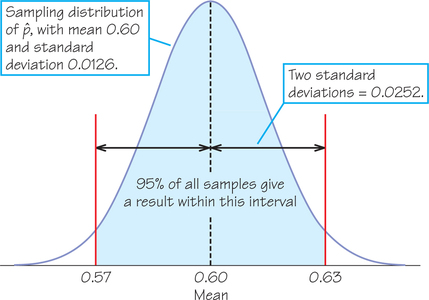EXAMPLE 17 The 68–95–99.7 Rule Again
The 68–95–99.7 Rule Again
In Example 16, the population parameter, the proportion of adults who agreed with some statement, is p=0.6. if we take SRSs of size 1500, the sample proportions ˆp follow the normal distribution with a mean of 0.6 and a standard deviation of 0.0126. The “95” part of the 68–95–99.7 rule from Section 5.9 (page 216) says that 95% of all samples give a ˆp within 2 standard deviations of the truth about the population. So in this example, 95% of all samples have ˆp within 2×0.0126 of 0.60, that is, between 0. 57 and 0.63 (rounded to two decimal places). Figure 7.10 illustrates this use of the 68–95–99.7 rule.

Rounding Numbers

Figure 7.10 The sampling distribution of ˆp for Example 16. By the 68–95–99.7 rule, 95% of all samples have a sample proportion ˆp within 0.0252 of the true population proportion p=0.6.
[Leave] [Close]